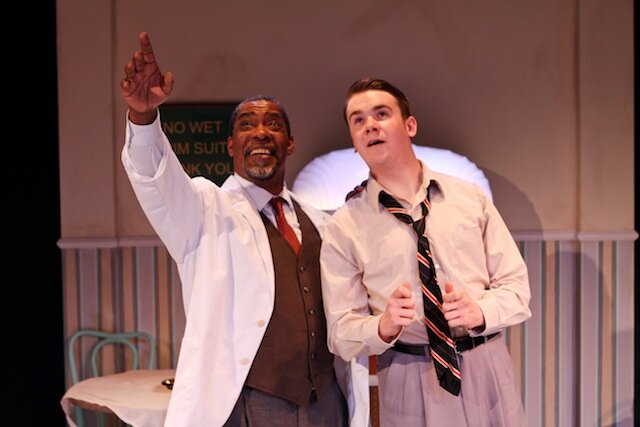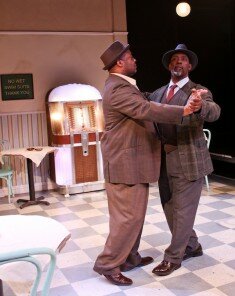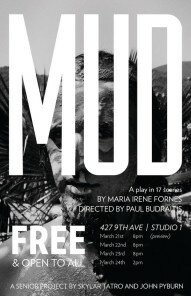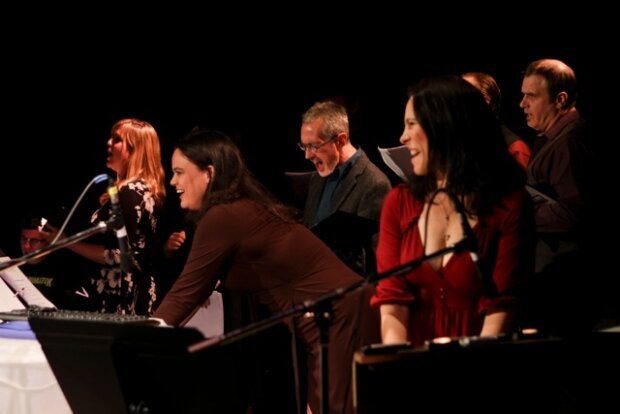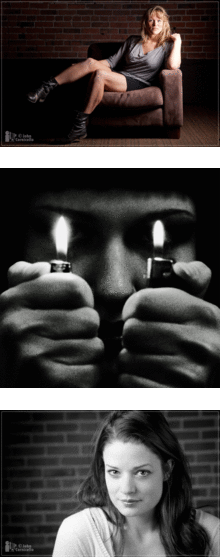Get ready, Seattle, here comes Beckettfest! Yes, More than a dozen performance producing organizations throughout Seattle will be performing works of Sam Beckett including Waiting for Godot and that one with people in the trash cans. It’s depressing. Nothing happens. It’s inscrutable. It’s slapstick!
Yes, Beckett is funny. If you’ve seen Beckett’s work you know—or at least suspect—that he draws as much from the music hall as the mortuary. Gags abound, but in a rarefied air that makes them as liable to produce tears—or at least existential dread—as laughter. Pulling off such duality takes a light touch.
Much of Life = Play (through August 24th at West of Lenin) has the touch of a toddler petting a cat: halting, forceful, and backwards. Yet it is not without pleasure in acting, in technical design, and in direction—just rarely all at once.
We begin with Act Without Words, easily the most accessible of the evening’s pieces, in which Ray Tagavilla puts aside his usual tough-guy act for full immersion in the life of the silent-movie pratfall masters Buster Keaton, Charlie Chaplin, and Harold Lloyd. His goal is simple survival. Both his obstacles and resources are surreal. His interactions are a stock series of failures.
This is all perfectly Beckettian and in good fun but the pathos is missing and we fail to care about our hero or share his struggle. Tagavilla gives it his all but never admits any vulnerability. Furthermore the ragtime soundtrack distances the action. By reinforcing the association with Chaplin et al., the music sets expectations that the actions fulfill with little surprise.
In Rockaby Susanna Burney rocks a rocking chair as the light shifts over the course of a day and the waning years of her life. AJ Epstein gets the credit, in this piece, for his lighting deisgn. Rockaby reduces the situation to an extreme simplicity evoking both the universal and the quotidian. Burney’s recorded voice lulls us in its insistent recital of text that fills in all the details of the moment in an interior stream-of-consciousness. The words are confused, repetitive, and desultory. The pieces leaves us feeling that we’ve spent a day with an aging person whose mind is prone to drift.
The uniformity and lack of action places our focus on such fine points as the pace of Burney’s rocking, which speeds and slows, rising to a final rush before suddenly ending. That rocking moves her face through the light. As the Georgian window and Venetian blind gobos speed over her features they create a strobe effect in which we catch her alternately lit from behind and below making it impossible to definitively read her emotions. All we trust is her determined demand and only spoken word: more. Even in nursing home monotony she demands “More”. In this we get to the fear and sadness beneath Beckett’s laughter.
A chuckle or two is easier to come by in the light, yet pensive, Come and Go–the highlight of the evening–in which three women share a bench. They are still and silent with similar but distinctly different shades to their waiting. Kate Kraay disapproves. Kate Sumpter begrudges. Rachel Delmar disdains. They present gossip and the bonds and belligerence that define socially active lives in insular communities. We laugh from familiarity. Though their actions are broad and representative the subtlety of the variations gives life to their characters and Beckett even delivers a semblance of hope in the end. In addition to the fine acting Sarah Mosher’s costumes take notice along with Epstein’s lights and sound.
The Life = Play staging of La Derniére Bande (performed and directed by Burke Walker) deviates from Beckett’s writing in small but significant ways (risky in such precise writing) by reviving the original script of what we know as Krapp’s Last Tape. It is performed in French with English supertitles. In fact it is most appropriate to use the promoted title: La Derniére Bande (Krapp’s Last Tape en Français with supertitles). After all, the supertitles are so disruptive that they deserve top billing.
Beckett’s world is subtle. The supertitles mean we are constantly looking away from the physical acting to concentrate on the text and therefore miss Walker’s responses to the text, which, as in Rockaby, is mostly recorded. It is Krapp’s interior world but a distanced one from the past.
Even in the broadly physical comedy of the piece Walker seems to work to subvert the comedy of Krapp’s Last Tape. Relating Krapp’s name, his intestinal difficulties, and their relationship to Krapp’s guilty pleasure of banana binging, Beckett wraps fart jokes inside banana peels. The set up is barn-big and the delivery misses with painful deliberation. There is a slip, and a fall, but Walker shows all the work and still delivers a lackluster product.
Failure is inherent in comedy, but the kind of failure in this production is not Jacques Lecoq’s expert who attempts his signature and fails. It is not the harried go-getter who outsmarts the system only to trip on his own pride. It’s not even just an actor working hard at nonchalance. This goes beyond bad acting to intentional failure, as if it were Walker, the director, performing the failure instead of Walker, the actor. The performance is constantly dying, and at a geologic pace that further subverts any pathos, comedy, or even interest.
The saving grace of short works collections is that anything one dislikes will be over soon. Life = Play offers enough variation from Beckett that most will find something to like.
